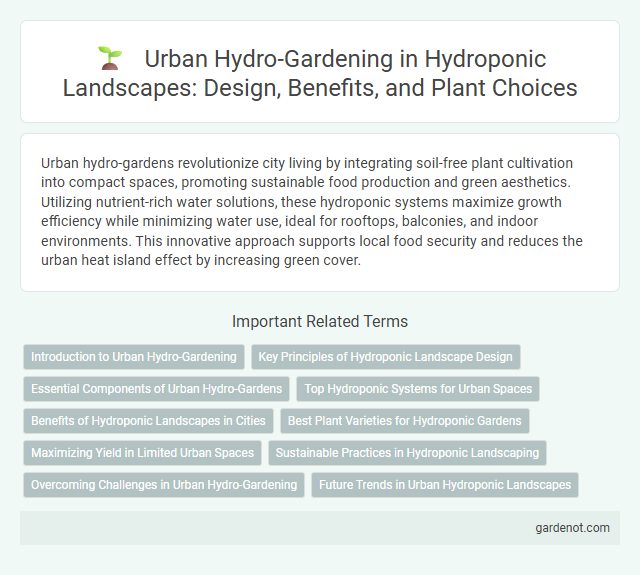Urban hydro-gardens revolutionize city living by integrating soil-free plant cultivation into compact spaces, promoting sustainable food production and green aesthetics. Utilizing nutrient-rich water solutions, these hydroponic systems maximize growth efficiency while minimizing water use, ideal for rooftops, balconies, and indoor environments. This innovative approach supports local food security and reduces the urban heat island effect by increasing green cover.
Introduction to Urban Hydro-Gardening
Urban hydro-gardening utilizes soil-less cultivation techniques that enable growing plants in controlled, water-based environments within city spaces. This method maximizes space efficiency, enhances crop yield, and reduces water consumption by recirculating nutrient-rich solutions directly to plant roots. Integrating vertical farming structures and automated systems supports sustainable food production in urban settings, addressing challenges like limited land and pollution.
Key Principles of Hydroponic Landscape Design
Urban hydro-gardens rely on key principles of hydroponic landscape design such as efficient water and nutrient management, optimized root aeration, and maximizing space through vertical or modular systems. Incorporating LED grow lights tailored to plant species ensures consistent photosynthesis independent of natural sunlight. These principles support sustainable urban agriculture by promoting higher yields and resource conservation in limited spaces.
Essential Components of Urban Hydro-Gardens
Urban hydro-gardens rely on essential components such as nutrient-rich water solutions, growing media like coco coir or perlite, and efficient irrigation systems to support plant growth without soil. LED grow lights provide optimal photosynthesis conditions, while pumps and timers regulate water circulation and feeding schedules. Structured frameworks including vertical racks or modular containers maximize space utilization in urban environments.
Top Hydroponic Systems for Urban Spaces
Urban hydro-gardens maximize limited space by utilizing top hydroponic systems like vertical towers, NFT (Nutrient Film Technique), and aeroponic mist systems, which enhance plant growth efficiency and yield. These systems optimize water and nutrient delivery directly to plant roots, reducing resource consumption while supporting high-density crop production in city environments. Innovative setups integrate smart sensors and automated controls for real-time monitoring, ensuring optimal conditions and sustainable urban agriculture.
Benefits of Hydroponic Landscapes in Cities
Urban hydro-gardens enhance city environments by maximizing green space utilization and improving air quality through efficient plant growth in controlled water-based systems. These hydroponic landscapes reduce water consumption by up to 90% compared to traditional soil gardening, promoting sustainable urban agriculture. They also support local food production, reducing transportation emissions and fostering biodiversity within metropolitan areas.
Best Plant Varieties for Hydroponic Gardens
Lettuce, spinach, and kale are among the best plant varieties for urban hydro-gardens due to their fast growth and high yield in soilless systems. Herbs such as basil, mint, and cilantro thrive in hydroponic environments and offer aromatic benefits along with culinary uses. Strawberries and cherry tomatoes also perform well, providing fresh produce in limited urban spaces while maximizing nutrient uptake and water efficiency.
Maximizing Yield in Limited Urban Spaces
Urban hydro-gardens employ vertical farming techniques and nutrient-rich water solutions to maximize crop yield in confined city environments. Precision-controlled lighting and climate systems enhance plant growth rates and optimize resource efficiency. Integration of space-saving modular designs allows for diverse plant cultivation on rooftops, balconies, and indoor areas, ensuring sustainable food production within limited urban spaces.
Sustainable Practices in Hydroponic Landscaping
Urban hydro-gardens utilize sustainable practices in hydroponic landscaping by conserving water through closed-loop irrigation systems that reduce waste by up to 90%. These systems integrate renewable energy sources, such as solar-powered pumps, to minimize carbon footprints while promoting efficient nutrient recycling to enhance plant growth without soil depletion. Implementing sustainable hydroponic techniques supports urban biodiversity and reduces reliance on traditional agriculture, contributing to greener city environments.
Overcoming Challenges in Urban Hydro-Gardening
Urban hydro-gardens face challenges such as limited space, inconsistent water quality, and fluctuating light conditions that demand innovative solutions for optimal plant growth. Integrating automated monitoring systems and efficient nutrient delivery tailored to urban environments enhances crop yield and reduces resource waste. Employing vertical farming techniques and selecting resilient plant varieties further overcome spatial constraints and environmental stressors inherent in city landscapes.
Future Trends in Urban Hydroponic Landscapes
Future trends in urban hydroponic landscapes emphasize the integration of AI-powered systems for precision nutrient management and optimized plant growth. Vertical hydro-gardens equipped with IoT sensors will enhance space efficiency and real-time monitoring in urban environments. Sustainable materials and renewable energy sources are increasingly adopted to create eco-friendly and scalable hydroponic solutions for city dwellers.
Urban hydro-garden Infographic

 gardenot.com
gardenot.com